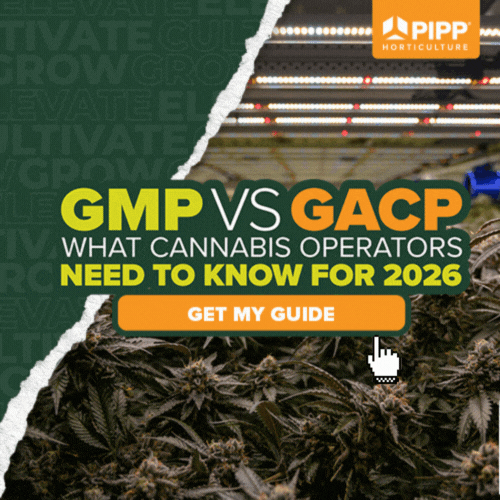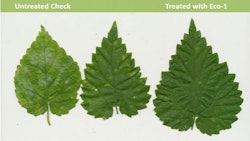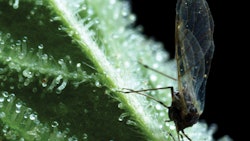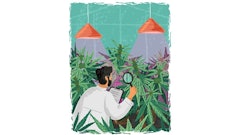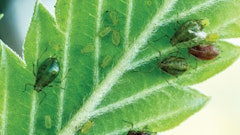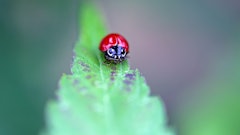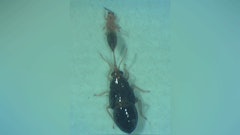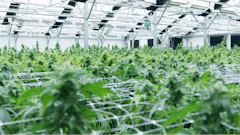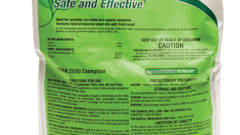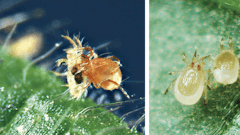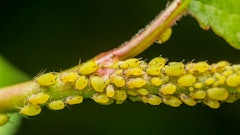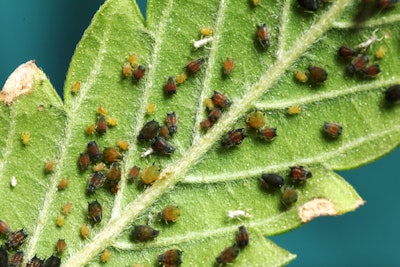
Insecticidal soaps and horticultural oils are contact pesticides (insecticides, miticides and fungicides) used in controlled environment production systems to suppress populations of certain insect and mite pests, and even prevent fungal infections. These products need to be applied thoroughly to all plant parts to ensure the product reaches the pest, as well as applied repeatedly due to this type of products’ short residual activity.
Insecticidal soaps and horticultural oils may also be used as surfactants to reduce the surface tension of water, which increases coverage by allowing the spray particles to spread over the leaf surface. Another benefit of insecticidal soaps and horticultural oils is their low mammalian toxicity (high LD50), meaning they have fewer harmful effects associated with human exposure. Furthermore, the probability of insect or mite pest populations developing resistance to insecticidal soaps and horticultural oils is extremely low due to their multiple modes of action (described later). Therefore, these pesticides can be incorporated into rotation programs to reduce the development of resistance to other pesticides. Insecticidal soaps and horticultural oils may also inhibit the ability of aphids to acquire viruses in plants, thus reducing potential transmission to other plants.
However, a concern when using these products is the possibility for plant injury (phytotoxicity) that can be influenced by temperature, relative humidity and stage of plant growth. To avoid plant injury, always water plants the day or night before applying insecticidal soaps or horticultural oils to minimize water stress. Plants experiencing water stress are more prone to plant injury. Also, apply these products when the temperature and relative humidity are at appropriate levels. Here are general descriptions of insecticidal soaps and horticultural oils that can help you in your integrated pest management efforts.
Insecticidal Soaps
Insecticidal soaps provide suppression of a variety of insect and mite pest populations that feed on controlled environment horticultural crops, including aphids, mealybugs, thrips, whiteflies and spider mites. Soaps are substances derived from the synthesis of an alkali, such as sodium (hard soap) or potassium (soft soap) hydroxide, on a fat. In general, fats are a blend of particular fatty acid chain lengths. Soap is a general term for the salts of fatty acids, which are the primary components of fats and oils present in plants and animals.
Soft-bodied insect and mite pests—such as aphids, mealybug crawlers, thrips, whiteflies and spider mites, including the twospotted spider mite (Tetranychus urticae)—are susceptible to soap applications. Insecticidal soaps are only effective when insect and mite pests come into contact with wet sprays. Dried residues on plant surfaces have minimal (if any) activity on insect or mite pests, with residues degrading rapidly when exposed to sunlight. Insecticidal soaps are most effective on larvae, nymphs and adults of soft-bodied insects and mites with minimal activity on eggs.
The mode of action of insecticidal soaps is still not well-understood, although there may be four ways by which insecticidal soaps kill insect and mite pests:
1. Insecticidal soaps penetrate through fatty acids present in the insect’s outer covering (cuticle), which dissolves or disrupts cell membranes, resulting in water loss. Consequently, cell integrity is impaired, causing cells to leak and collapse, and respiratory functions are destroyed, resulting in dehydration and death.
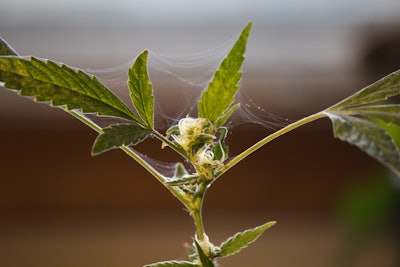
2. Insecticidal soaps may act as insect growth regulators by interfering with cell metabolism and production of growth hormones during metamorphosis (change in form).
3. Insecticidal soaps may block the breathing pores (spiracles), thus interfering with respiration.
4. Insecticidal soaps may uncouple oxidative phosphorylation (a process in which adenosine triphosphate (ATP) is formed) or reduce the production of energy by inhibiting ATP.
A variety of fatty acids exist; however, only certain fatty acids have insecticidal activity, which is based on the length of the carbon-based fatty acid chains. Most insecticidal soaps with insect and mite pest activity are composed of long-chain fatty acids (10- or 18-carbon chains); whereas shorter-chain fatty acids (9-carbon chains or less) have herbicidal properties, so using materials containing short-chain fatty acids can kill plants.
For example, oleic acid, an 18-chain carbon-based fatty acid that is present in olive oil and other vegetable oils, is effective as an insecticidal soap. In fact, most commercially available insecticidal soaps contain potassium oleate (potassium salt of oleic acid). Water quality may impact the activity of insecticidal soaps as hard water reduces the effectiveness of applications.
Insecticidal soaps may be directly and indirectly harmful to natural enemies, including predators and parasitoids, which can disrupt biological control programs. For instance, ladybird beetle and green lacewing larvae are killed by wet sprays on treated plant leaves. In addition, insecticidal soaps may be harmful to the predatory mite Phytoseiulus persimilis. A 4-percent application rate of insecticidal soap can result in 80-percent to 99-percent mortality of the predatory mite Neoseiulus (Amblyseius) cucumeris. In addition, the larval stages of the parasitoid Encarsia formosa are more susceptible to insecticidal soap wet sprays than the adults.
M-Pede, which contains potassium salts of fatty acids (49-percent active ingredient), is the commercially available insecticidal soap product registered for use in greenhouses and indoor plants. (Be sure to check your state regulations to determine if its application is permitted.)
Horticultural Oils
Numerous horticultural oils contain petroleum, paraffinic, mineral or neem as the active ingredient. Horticultural oils can provide suppression of populations of aphids, mealybugs, thrips, whiteflies and spider mites. Thorough coverage of all plant parts is important in order for the material to contact pests, and multiple applications will be required due to the short residual activity of horticultural oils.
However, avoid applying horticultural oils when the temperature is greater than or equal to 80 degrees Fahrenheit, and relative humidity is greater than 90 percent. The slower the horticultural-oil wet residues evaporate from the leaf surface, the higher the probability for plant injury. Therefore, horticultural oil applications should be made when temperatures are between 40 degrees and 75 degrees Fahrenheit.
Horticultural oils kill the eggs of insect and mite pests by means of multiple modes of action, including: preventing normal gas exchange through the insect cuticle, as well as interfering with water balance inside the egg, softening or dissolving the egg covering, or interfering with hormone or enzyme activity. When used against larvae, nymphs or adults, horticultural oils act by means of suffocation by blocking the breathing pores. They may also penetrate the insect cuticle and disrupt the functionality of the internal contents, or soften the cuticle resulting in a loss of water (dehydration). Eggs and immature life stages may be more susceptible to horticultural oils than adults. Horticultural oils may have repellent activity, thus decreasing egg-laying and feeding. These products, like insecticidal soaps, may be directly and indirectly harmful to natural enemies.

